Garden and Plant Delights
I’m fresh back from Raleigh, North Carolina where I attended the annual Garden Writers Association Symposium. My last post described some of our pre-conference plant geekery. But there was one more garden pilgrimage planned before the conference started: a personal tour of the specialty plant nursery Plant Delights Nursery in Raleigh with owner Tony Avent. This renowned mail-order firm also has an on-site botanical garden with some 17,000 taxa (unique plants), beautifully arranged and labeled, and an education center with classroom space.
Tony Avent’s politics have earned some complaint letters from progressives and others who object to the (questionably) humorous political mockery displayed on the cover of his catalogs. Still, his plant collection is astonishing and his depth of knowledge of plants and gardening is profound. We were in plant heaven.
After immersing ourselves in the glorious diversity of Plant Delights, the pre-conference gawking was officially over. But I had four more days of GWA-organized plant tours (with a full schedule of sessions and meetings between) ahead of me. Well, me and about 650 other garden writers and plant industry professionals!
First stop: the Sarah P. Duke Garden in Chapel Hill. This 55-acre public garden flanking Duke University consists of four areas: the formal "historic" gardens and terraces designed by landscape architect Ellen Shipman (1869-1950); the H.L. Blomquist Garden of Native Plants; the W.L. Culberson Asiatic Arboretum; and the Doris Duke Center Gardens. There was some really fine container plantings and unusual plant bedding material but the most photogenic by far was the lily pad pond.
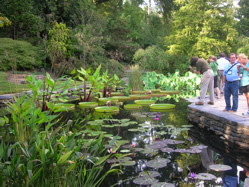
Avid garden writers flocking the photogenic lily pond at the Duke Garden
After another few hours of buying plants at Plant Delights (we’d only ogled them with the proprietor the first time ’round), we visited the J.C. Raulston Arboretum in Raleigh. This truly extraordinary garden was named in honor of its late director and founder, a much-admired plantsman and professor of horticultural science at NC State. The garden contains over 5,000 taxa (different kinds of plants). In addition to acres of woody and herbaceous plants laid out in large island beds for evaluation, there was a xeric garden with a wide range of drought-tolerant plants and scree gardens, which display plants native to hot, dry regions of South Africa, Mexico, the Mediterranean and the southwestern US. Unfortunately, it was raining and dusk was falling while we toured the garden so my photos were disappointing.
Raleigh is situated in USDA Zone 7b (winter lows of 5F to 10 F) so there are close parallels to our region’s Zone 8a/7b climate. It was exciting to see so many new plants – if they can grow in Raleigh, there’s a very good chance they’ll grow in Portland, OR. The upshot? In the name of science, I shipped home a bunch of hardy gloxinias, tradescantias, aloes and bulbs so I could try them out myself.
The North Carolina Botanical Garden in Chapel Hill displayed many native North Carolina ecosystems beautifully including the coastal plains, the Piedmont (central North Carolina), and western NC’s mountains, as well as native gardens devoted to shade, fern, carnivorous, and rare plants.
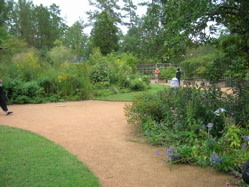
Native perennials of the Southeastern US are more diverse in form and colorful than in the PNW
Devoted to plant and resource conservation, the gardens and building are built and maintained with green principles in mind, from the ecologically sound plantings to the permeable driveway and new green building that will likely be the first LEED Platinum building in NC when finished.
The last garden on the tour was Montrose in Hillsborough. Now a Garden Conservancy property, this amazing garden is the home of Nancy and Craufurd Goodwin. The grounds include several romantic 19th century buildings, rock and scree gardens, woodlands, unusual trees, luscious container plantings, and exquisite meadowy perennial and shrub beds. I first heard of Nancy Goodwin while reading Allan Lacy’s "The Garden in Autumn," published in 1990 and still my favorite book on the season. Goodwin’s garden had attained quasi-religious status for me so it was an essential visit, even if it meant missing my plane, which I very nearly did. While I didn’t have enough time to savor the exquisitely sensitive interplay between formality and wildness there, I did snap some photos, which I can savor. I hope you can, too.
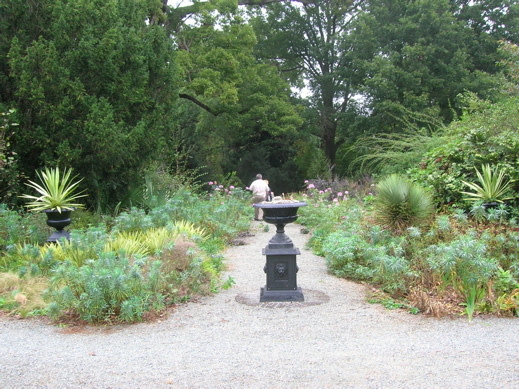
This is a classic scene of Montrose (minus the nurseryman in the distance)
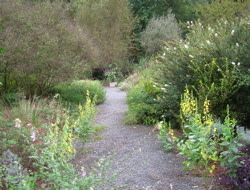
Some of the borders at Montrose
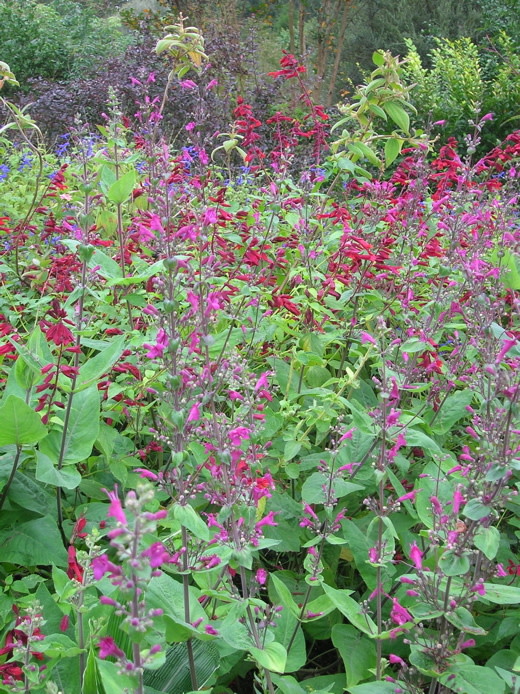
Red, pink and blue salvias at Montrose. The garden had a tangled elegance about it which contrasted beautifully with the formality of the house and layout of the property

